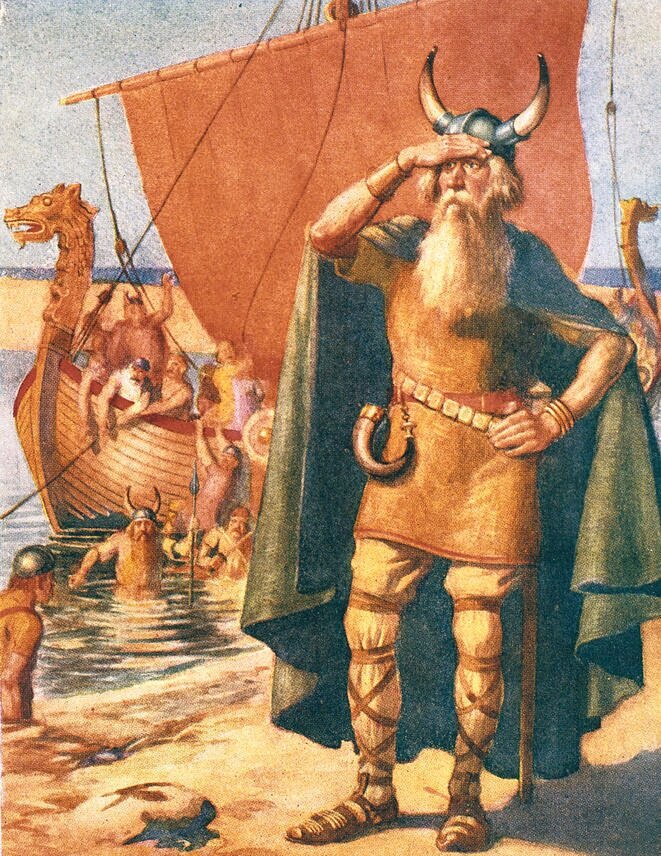Vikings In Vinland
The Europeans in North America
The history books teach of Columbus sailing the ocean blue and discovering America in 1492. It’s a nice nursery rhyme but the truth is far more complex. In fact, Columbus, on his first voyage, stayed primarily in the Caribbean. In European history, it was John Cabot, in 1497, who made his way to Canada to formally discover the North American continent.
Our story, however, starts more than 500 years before that when the brave seafarers known as Vikings discovered North America by landing in the Canadian Arctic near present-day Newfoundland. Today, the mythology of Vikings is much more popular than decades past. Successful shows like the History Channel’s “Vikings” and even the video game “Skyrim” have brought their culture into the forefront of our zeitgeist.
Eugene Linden in a Smithsonian magazine article titled “Did the Vikings Discover North America?” highlights that: “All the detail about Norse trips to Vinland (as the Norse called North America) comes from two accounts: The Saga of Erik the Red and The Saga of the Greenlanders.”
“These epic Viking tales were probably first written down around 1200 or 1300 by scribes who either recorded the oral stories of elders or worked from some now-lost written source, says Thor Hjaltalin, an Icelandic scholar who oversees archaeological activities in northwest Iceland.”
This gap of a few hundred years makes the sagas fairly contemporary to the events. They have been supported or partly verified through known family lineages, recorded weather events, and archeological evidence unearthed in North America, Greenland, and Iceland.
According to the sagas, in 985, while sailing from Iceland to Greenland with a migration fleet consisting of 400–700 settlers and 25 other ships (14 of which completed the journey), a merchant named Bjarni Herjólfsson was blown off course, and after three days' sailing, he sighted land west of the fleet. Only 14 ships survived the journey to Greenland and Bjarni was only interested in finding his father's farm, but he described his findings to Leif Erikson, son of Erik the Red.
Even though the Greenland settlement was fairly new, Bjarni’s discoveries excited a lot of interest. When Bjarni decided to give up trading, Leif Erikson bought his Knarr, or ship, and set off with a crew of 35 on a follow-up expedition.
Leif and others had wanted his father, Erik the Red, to lead this expedition and talked him into it. However, as Erik attempted to join his son Leif on the voyage, he fell off his horse when it slipped on wet rocks near the shore. His injuries kept him from joining his son.
John Harwood continues the story in an excellent piece on Historyextra.com titled “Who Discovered America”. He says: “Leif began by reversing Bjarni’s course. Using the routes, landmarks, currents, rocks, and winds that Bjarni had described to him, Leif sailed from Greenland westward across the Labrador Sea. Sailing north-west, Leif came to a land of bare rock and glaciers which he called ‘Slab Land’. Turning south, Leif next came to a low forested land with white sand beaches which he decided to call ‘Forest Land’.”
Harwood goes on to detail: “Sailing south-west for two days Leif discovered a land where the rivers teemed with salmon and grapes grew wild. This Leif called Vinland or ‘Wine Land’. The party built houses at a place afterward called ‘Leif’s booths’, where they spent a comfortable winter. The country seemed to them so kind that no winter fodder would be needed for livestock: there was never any frost all winter and the grass hardly withered at all.”
According to the sagas, the Norse found the Vinland weather to be much milder than the harsh Greenland winter. At this lower latitude, the days were much longer in the winter, and they described “on the shortest day of the year, the sun was visible in the middle of the afternoon as well as at breakfast time”.
In his book, “The Seafarers: The Vikings”, Robert Wernick details why, perhaps, the settlement was known as Vinland. He said: “Leif wintered in 1001, probably near Cape Bauld on the northern tip of Newfoundland. One day his foster father Tyrker was found drunk, on what the saga describes as "wine-berries." Squashberries, gooseberries, and cranberries all grew wild in the area. There are varying explanations of Leif apparently describing these fermented berries as "wine."
In the Spring, Leif and his men filled their boat with timber, which was non-existent in Greenland, and sailed for home. At that time there was no direct contact or conflict with the natives. Soon, his brother would travel to Vinland on his own exploration, but he will find a much more aggressive population of Indians, and his trip will end in a key crew member’s death.
Episode 2: Vikings in North America
To re-imagine Norse exploration of North America check out Episode 2: Vikings in Vinland. We look at what caused the demise of Norse settlements and how they could have been successful.
Our podcast envisions a different American history, and we walk the streets of a bustling Norse city on the shores of what will become New York City. All of this, 200 hundred years before Christopher Columbus.



